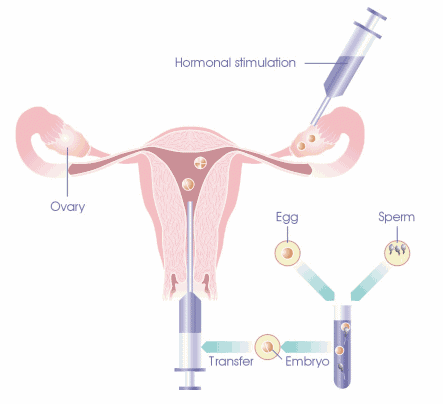| Normally, an egg and sperm are fertilized inside a woman’s body. If the fertilized egg attaches to the lining of the womb and continues to grow, a baby is born about 9 months later. This process is called natural or unassisted conception.
IVF is a form of assisted reproductive technology (ART). This means special medical techniques are used to help a woman become pregnant. IVF has been successfully used since 1978. It is most often tried when other, less expensive fertility techniques have failed.
There are five basic steps to IVF:
Step 1: Stimulation, also called super ovulation
Medicines, commonly called fertility drugs, are given to the woman to boost her egg production. Normally, a woman produces one egg per month. Fertility drugs tell the ovaries to produce several eggs. During this step, the woman will have regular transvaginal ultrasounds to examine the ovaries and blood tests to check hormone levels.
Step 2: Egg retrieval
A minor surgery, called follicular aspiration, is done to remove the eggs from the woman’s body. The surgery is normally done as an outpatient procedure in the doctor’s office. The woman will be given medicines so she does not feel pain during the procedure. Using ultrasound images as a guide, the health care provider inserts a thin needle through the vagina and into the ovary and sacs (follicles) containing the eggs. The needle is connected to a suction device, which pulls the eggs and fluid out of each follicle, one at a time. The procedure is repeated for the other ovary. The woman may have some cramping after the surgery, but it usually goes away within a day. In rare cases, a pelvic laparoscopy may be needed to remove the eggs.
If a woman does not or cannot produce any eggs, donated eggs may be used.
Step 3: Insemination and Fertilization
The man’s sperm is placed together with the best quality eggs and stored in an environmentally controlled chamber. The mixing of the sperm and egg is called insemination. The sperm usually enters (fertilizes) an egg a few hours after insemination. If the doctor thinks the chance of fertilization is low, the laboratory staff may directly inject the sperm into the egg. This is called intracytoplasmic sperm injection (ICSI). Many fertility programs routinely do ICSI on some of the eggs even if everything is normal.

Step 4: Embryo culture
When the fertilized egg divides, it becomes an embryo. Laboratory staff will regularly check the embryo to make sure it is growing properly. Within about 5 days, a normal embryo has several cells that are actively dividing.
Couples who have a high risk of passing a genetic (hereditary) disorder to a child may consider pre-implantation genetic diagnosis (PGD). The procedure is done about 3 -4 days after fertilization. Laboratory scientists remove a single cell from each embryo and screen the material for specific genetic disorders. According to the American Society for Reproductive Medicine, PGD can help parents decide which embryos to implant, which decreases the chance of passing a disorder onto a child. The technique is controversial and not offered at all centers.
Step 5: Embryo transfer
Embryos are placed into the woman’s womb 3 - 5 days after egg retrieval and fertilization. The procedure is done in the doctor’s office while the woman is awake. The doctor inserts a thin tube (catheter) containing the embryos into the woman’s vagina, through the cervix, and up into the womb. If an embryo sticks to (implants) in the lining of the womb and grows, pregnancy results.
More than one embryo may be placed into the womb at the same time, which can lead to twins, triplets, or more. The exact number of embryos transferred is a complex issue that depends on many factors, especially the woman’s age. Unused embryos may be frozen and implanted or donated at a later date.
|



